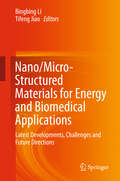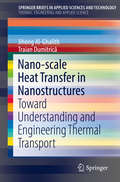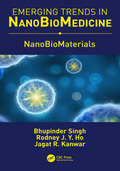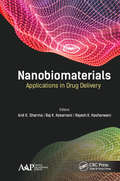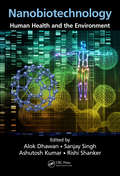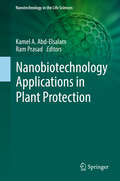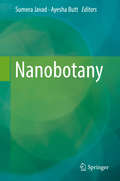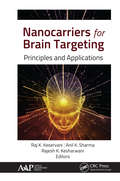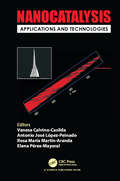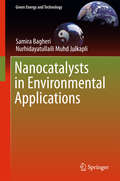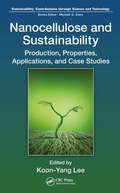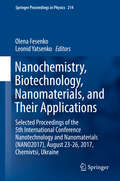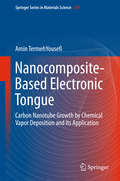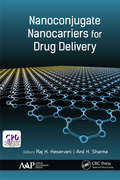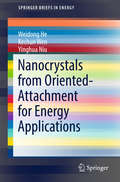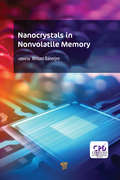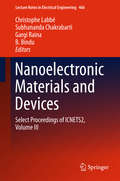- Table View
- List View
Nano/Micro-Structured Materials for Energy and Biomedical Applications: Latest Developments, Challenges and Future Directions
by Bingbing Li Tifeng JiaoThis book discusses the latest developments of the synthesis, preparation, characterization, and applications of nano/microstructure-based materials in biomedical and energetic fields. It introduces several popular approaches to fabricating these materials, including template-assisted fabrication, electrospinning of organic/inorganic hybrid materials, biomineralization-mediated self-assembly, etc. The latest results in material evaluation for targeted applications are also presented. In particular, the book highlights the latest advances and future challenges in polymer nanodielectrics for energy storage applications. As such, it offers a valuable reference guide for scholars interested in the synthesis and evaluation of nano/microstructure-based materials, as well as their biomedical and energetic applications. It also provides essential insights for graduate students and scientists pursuing research in the broad fields of composite materials, polymers, organic/inorganic hybrid materials, nano-assembly, etc.
Nano-scale Heat Transfer in Nanostructures: Toward Understanding and Engineering Thermal Transport (SpringerBriefs in Applied Sciences and Technology)
by Jihong Al-Ghalith Traian DumitricăThe book introduces modern atomistic techniques for predicting heat transfer in nanostructures, and discusses the applications of these techniques on three modern topics. The study of heat transport in screw-dislocated nanowires with low thermal conductivity in their bulk form represents the knowledge base needed for engineering thermal transport in advanced thermoelectric and electronic materials, and suggests a new route to lower thermal conductivity that could promote thermoelectricity. The study of high-temperature coating composite materials facilitates the understanding of the role played by composition and structural characterization, which is difficult to approach via experiments. And the understanding of the impact of deformations, such as bending and collapsing on thermal transport along carbon nanotubes, is important as carbon nanotubes, due to their exceptional thermal and mechanical properties, are excellent material candidates in a variety of applications, including thermal interface materials, thermal switches and composite materials.
NanoBioMaterials
by Bhupinder SinghThe present book volume presents a holistic view of the aspects of nanobiomaterials incl. their stellar merits and limitations, applications in diverse fields, their futuristic promise in the fields of biomedical science and drug delivery. The federal & regulatory issues on the usage of nanobiomaterials have been assigned due consideration.
Nanobiomaterials: Applications in Drug Delivery
by Anil K. Sharma Raj K. Keservani Rajesh K. KesharwaniThis new volume focuses on the ever-growing and ever-sophisticated use of nanobiomaterials in drug delivery. There have been significant developments in the delivery of the active pharmaceutical ingredients to target sites, thereby sparing the normal functioning biological systems from damage, and this volume highlights some of the most important developments in the field. The book first provides an overview of nanobiomaterials and then goes on to report on new developments in drug delivery and nanotechnology, nanobiomaterials as carriers in cancer therapy, and the diverse uses of nanobiomaterials. Broken into sections, the chapters cover: an overview of nanobiomaterials drug delivery and nanotechnology nanobiomaterials as carriers in cancer therapeutics diverse uses of nanobiomaterials This volume will be a valuable resource on drug delivery for pharmaceutical manufacturers, healthcare personnel, and researchers.
Nanobiomaterials: Applications in Drug Delivery
by Anil K. Sharma Raj K. Keservani Rajesh K. KesharwaniThis new volume focuses on the ever-growing and ever-sophisticated use of nanobiomaterials in drug delivery. There have been significant developments in the delivery of the active pharmaceutical ingredients to target sites, thereby sparing the normal functioning biological systems from damage, and this volume highlights some of the most important developments in the field. The book first provides an overview of nanobiomaterials and then goes on to report on new developments in drug delivery and nanotechnology, nanobiomaterials as carriers in cancer therapy, and the diverse uses of nanobiomaterials. Broken into sections, the chapters cover: an overview of nanobiomaterials drug delivery and nanotechnology nanobiomaterials as carriers in cancer therapeutics diverse uses of nanobiomaterials This volume will be a valuable resource on drug delivery for pharmaceutical manufacturers, healthcare personnel, and researchers.
NanoBioMaterials
by Bhupinder Singh Rodney J. Y. Ho Jagat R. KanwarThe present book volume presents a holistic view of the aspects of nanobiomaterials incl. their stellar merits and limitations, applications in diverse fields, their futuristic promise in the fields of biomedical science and drug delivery. The federal & regulatory issues on the usage of nanobiomaterials have been assigned due consideration.
Nanobiotechnology: Human Health and the Environment
by Alok Dhawan Sanjay Singh Ashutosh Kumar Rishi ShankerThis book combines the contributions from the experts of material science, molecular biology, toxicology bio-organic and bio-inorganic chemistry, toxicologists and environmental and food technology etc. to fathom the full scope of current and future of developments in the area of Nanobiotechnology. Provides brief overview of nanobiotechnology for general readers who are not familiar with the research fields and presents a strong overview of most of the critical areas in field This book can also be used as text book for graduate students as an essential reference material, and as an reading material for general readers having a curiosity in Nanobiotechnology.
Nanobiotechnology: Human Health and the Environment
by Alok Dhawan, Sanjay Singh, Ashutosh Kumar and Rishi ShankerThis book combines the contributions from the experts of material science, molecular biology, toxicology bio-organic and bio-inorganic chemistry, toxicologists and environmental and food technology etc. to fathom the full scope of current and future of developments in the area of Nanobiotechnology. Provides brief overview of nanobiotechnology for general readers who are not familiar with the research fields and presents a strong overview of most of the critical areas in field This book can also be used as text book for graduate students as an essential reference material, and as an reading material for general readers having a curiosity in Nanobiotechnology.
Nanobiotechnology Applications in Plant Protection (Nanotechnology in the Life Sciences)
by Kamel A. Abd-Elsalam Ram PrasadNanotechnology can target specific agricultural problems related to plant pathology and provide new techniques for crop disease control. Plant breeders and phytopathologists are needed who can apply nanogenomics and develop nanodiagnostic technologies to accurately advance the improvement process and take advantage of the potential of genomics. This book serves as a thorough guide for researchers working with nanotechnology to address plant protection problems.Novel nanobiotechnology methods describe new plant gene transfer tools that improve crop resistance against plant diseases and increase food security. Also, quantum dots (QDs) have emerged as essential tools for fast and accurate detection of particular biological markers. Biosensors, QDs, nanostructured platforms, nanoimaging, and nanopore DNA sequencing tools have the potential to raise sensitivity, specificity, and speed in pathogen detection, thereby facilitating high-throughput analysis and providing high-quality monitoring and crop protection. Also, this book deals with the application of nanotechnology for quicker, more cost-effective, and precise diagnostic procedures of plant diseases and mycotoxins. Applications of nanotechnology in plant pests and disease control, antimicrobial mechanisms, pesticides remediation and nanotoxicity on plant ecosystem and soil microbial communities are discussed in detail. Moreover, the application of specific nanomaterials including silver, copper, carbon- or polymer-based nanomaterials and nanoemulsions are also discussed. Crops treated with safe nanofertilizers and nanopesticides will gain added value because they are free of chemical residues, decay and putative pathogens for human health, sustaining the global demand for high product quality.
Nanobotany
by Sumera Javad Ayesha ButtThis work synthesizes research and practical work, including various techniques and applications of botany and nanoparticles, including enzymology, pharmaceuticals, phenolics, antioxidants, metal particles, synthesis of nanoparticles by plants and microbes, and more. The text discusses the latest research as well as key sources of information condensed from other scholars across the globe, providing a comprehensive resource for scholars working in nanobotany, as well as chemists and researchers in the pharmaceutical industry.
Nanocarriers for Brain Targeting: Principles and Applications
by Raj K. Keservani Anil K. Sharma Rajesh K. KesharwaniThis new volume, Nanocarriers for Brain Targeting: Principles and Applications, covers recent research on brain physiology and the development of drug delivery systems. It explores a diverse variety of strategies that can be employed to achieve drug targeting to the brain. The nanocarriers that are discussed include nanoparticles, vesicular carriers, carriers having carbon as a core constituent, dispersed systems, and more. The inherent anatomy and physiology of the brain renders it different from other organs. The past few decades have witnessed significant research on brain ailments in response to a majority of hospitalizations that occur due to age-related central nervous system disorders. The prevalence of diverse diseases such as Alzheimer’s disease, Parkinson’s disease, amyotrophic lateral sclerosis, multiple sclerosis, HIV-dementia, etc., affect about 1.5 billion people globally, which is further anticipated to reach 1.9 billion by the year 2020. Nanocarriers for drug delivery to the brain are seen as one of the answers to this growing problem.
Nanocarriers for Brain Targeting: Principles and Applications
by Raj K. Keservani Anil K. Sharma Rajesh K. KesharwaniThis new volume, Nanocarriers for Brain Targeting: Principles and Applications, covers recent research on brain physiology and the development of drug delivery systems. It explores a diverse variety of strategies that can be employed to achieve drug targeting to the brain. The nanocarriers that are discussed include nanoparticles, vesicular carriers, carriers having carbon as a core constituent, dispersed systems, and more. The inherent anatomy and physiology of the brain renders it different from other organs. The past few decades have witnessed significant research on brain ailments in response to a majority of hospitalizations that occur due to age-related central nervous system disorders. The prevalence of diverse diseases such as Alzheimer’s disease, Parkinson’s disease, amyotrophic lateral sclerosis, multiple sclerosis, HIV-dementia, etc., affect about 1.5 billion people globally, which is further anticipated to reach 1.9 billion by the year 2020. Nanocarriers for drug delivery to the brain are seen as one of the answers to this growing problem.
Nanocatalysis: Applications and Technologies
by Vanesa Calvino-Casilda Antonio José López-Peinado Rosa María Martín-Aranda Elena Pérez MayoralSynthesis and design of new nanocatalysts is an important area of research that aims to introduce multiple types of useful applications in a greener market. The necessity of nanostructuring the active sites has emerged as the key point in a successful design of the catalysts. The book covers the progress in this research area done in the last ten years. It includes the classification of catalysts and structure of active sites at the nanoscale. The book covers examples to present the concept, evolution of nanocatalysts from the perspective of chemistry of materials and their applications.
Nanocatalysis: Applications and Technologies
by Vanesa Casilda–Calvino Antonio José López-Peinado Rosa María Martín-Aranda Elena Pérez-MayoralSynthesis and design of new nanocatalysts is an important area of research that aims to introduce multiple types of useful applications in a greener market. The necessity of nanostructuring the active sites has emerged as the key point in a successful design of the catalysts. The book covers the progress in this research area done in the last ten years. It includes the classification of catalysts and structure of active sites at the nanoscale. The book covers examples to present the concept, evolution of nanocatalysts from the perspective of chemistry of materials and their applications.
Nanocatalysts in Environmental Applications (Green Energy and Technology)
by Samira Bagheri Nurhidayatullaili Muhd JulkapliThis book presents a range of nanocatalysts, together with their primary environmental applications and use in chemical production processes. In addition, it describes the nanomaterials used for catalysts and details their performance.The book introduces readers to the fundamentals and applications of nanocatalysis, synthesis, characterization, modification and application. Further topics include: landfill organic pollutant photodegradation; magnetic photocatalysis; synergistic effects on hydrogenated TiO2; and photoinduced fusion of gold-semiconductor nanoparticles.A detailed explanation of the chemistry of nanostructures and the ability to control materials at the nano-scale rounds out the coverage. Given the central importance of research in nanotechnology and nanoscience for the development of new catalysts, the book offers a valuable source of information for researchers and academics alike. It will also benefit industrial engineers and production managers who wish to understand the environmental impact of nanocatalysts.
Nanocellulose and Sustainability: Production, Properties, Applications, and Case Studies (Sustainability: Contributions through Science and Technology)
by Koon-Yang LeeNanometre scale cellulose fibres, or nanocellulose, are emerging materials for various advanced applications. Nanocellulose and Sustainability: Production, Properties, Applications, and Case Studies provides a comprehensive overview of nanocellulose production, nanocellulose properties and nanocellulose in selected applications. This book serves as an entry level reference text for undergraduates, graduate students, researchers and professional engineers working in the area of nanocellulose and sustainability. Features: Summarises the surface and bulk properties of various types of nanocellulose Reviews the application of nanocellulose in water purification and optically transparent materials Provides an overview of nanocellulose as Pickering emulsifier, binder for loose natural fibres to produce non-woven preforms, as well as nanocellulose-based aerogels Presents a techno-economic analysis of industrial bacterial cellulose production Discusses the pilot scale production of cellulose nanocrystals
Nanocellulose and Sustainability: Production, Properties, Applications, and Case Studies (Sustainability: Contributions through Science and Technology)
by Koon-Yang LeeNanometre scale cellulose fibres, or nanocellulose, are emerging materials for various advanced applications. Nanocellulose and Sustainability: Production, Properties, Applications, and Case Studies provides a comprehensive overview of nanocellulose production, nanocellulose properties and nanocellulose in selected applications. This book serves as an entry level reference text for undergraduates, graduate students, researchers and professional engineers working in the area of nanocellulose and sustainability. Features: Summarises the surface and bulk properties of various types of nanocellulose Reviews the application of nanocellulose in water purification and optically transparent materials Provides an overview of nanocellulose as Pickering emulsifier, binder for loose natural fibres to produce non-woven preforms, as well as nanocellulose-based aerogels Presents a techno-economic analysis of industrial bacterial cellulose production Discusses the pilot scale production of cellulose nanocrystals
Nanochemistry, Biotechnology, Nanomaterials, and Their Applications: Selected Proceedings of the 5th International Conference Nanotechnology and Nanomaterials (NANO2017), August 23-26, 2017, Chernivtsi, Ukraine (Springer Proceedings in Physics #214)
by Olena Fesenko Leonid YatsenkoThis book presents some of the latest achievements in nanotechnology and nanomaterials from leading researchers in Ukraine, Europe, and beyond. It features selected peer-reviewed contributions from participants in the 5th International Science and Practice Conference Nanotechnology and Nanomaterials (NANO2017) held in Chernivtsi, Ukraine on August 23-26, 2017. The International Conference was organized jointly by the Institute of Physics of the National Academy of Sciences of Ukraine, Ivan Franko National University of Lviv (Ukraine), University of Tartu (Estonia), University of Turin (Italy), and Pierre and Marie Curie University (France). Internationally recognized experts from a wide range of universities and research institutions share their knowledge and key results on topics ranging from energy storage to biomedical applications. This book's companion volume also addresses nanooptics, nanoplasmonics, and interface studies.
Nanocomposite-Based Electronic Tongue: Carbon Nanotube Growth by Chemical Vapor Deposition and Its Application (Springer Series in Materials Science #259)
by Amin TermehYousefiThis book describes the fabrication of a frequency-based electronic tongue using a modified glassy carbon electrode (GCE), opening a new field of applying organic precursors to achieve nanostructure growth. It also presents a new approach to optimizing nanostructures by means of statistical analysis. The chemical vapor deposition (CVD) method was utilized to grow vertically aligned carbon nanotubes (CNTs) with various aspect ratios. To increase the graphitic ratio of synthesized CNTs, sequential experimental strategies based on response surface methodology were employed to investigate the crystallinity of CNTs. In the next step, glucose oxidase (GOx) was immobilized on the optimized multiwall carbon nanotubes/gelatin (MWCNTs/Gl) composite using the entrapment technique to achieve enzyme-catalyzed oxidation of glucose at anodic potentials, which was drop-casted onto the GCE. The modified GCE’s performance indicates that a GOx/MWCNTs/Gl/GC electrode can be utilized as a glucose biosensor with a high direct electron transfer rate between GOx and MWCNTs/Gl. It was possible to use the fabricated biosensor as an electronic tongue thanks to a frequency-based circuit attached to the electrochemical cell. The results indicate that the modified GCE (with GOx/MWCNTs/Gl) holds promising potential for application in voltammetric electronic tongues.
Nanoconjugate Nanocarriers for Drug Delivery
by Raj K. Keservani Anil K. SharmaThis new volume presents a plethora of new research on the use of nanoconjugate nanocarriers in drug delivery. Nanotechnology as drug carriers has been observed to increase the level of sophistication through a variety of ways. It helps to alleviate some of the pitfalls of conventional dosage forms, such as few pitfalls such as non-specific drug delivery, dose dumping, poor patient compliance, toxicities linked with higher doses, etc. With chapters from highly skilled, experienced, and renowned scientists and researchers, Nanoconjugate Nanocarriers for Drug Delivery is divided into four sections, providing an introduction to nanocarriers for drug delivery, physicochemical features of nanocarriers, and specific applications dealing with drug delivery in particular. The materials used as well as formulation and characterization have been discussed in detail. The nanocarriers covered in the book include nanoparticles, vesicular carriers, carriers having carbon as the core constituent, dispersed systems, etc. The book also delves into the interaction and associations between drug delivery research and its therapeutic applications in practice. The book integrates a wide variety of case studies, research, and theories in an attempt to reveal the diversity and capture the novel approaches of nanoconjugate nanocarriers for drug delivery employed by developers and content experts in the field. This timely publication will be an essential reference and current awareness source, building on the available literature in the field of pharmacy and biomedical science, while also providing ideas for further research opportunities in this dynamic field.
Nanoconjugate Nanocarriers for Drug Delivery
by Raj K. Keservani Anil K. SharmaThis new volume presents a plethora of new research on the use of nanoconjugate nanocarriers in drug delivery. Nanotechnology as drug carriers has been observed to increase the level of sophistication through a variety of ways. It helps to alleviate some of the pitfalls of conventional dosage forms, such as few pitfalls such as non-specific drug delivery, dose dumping, poor patient compliance, toxicities linked with higher doses, etc. With chapters from highly skilled, experienced, and renowned scientists and researchers, Nanoconjugate Nanocarriers for Drug Delivery is divided into four sections, providing an introduction to nanocarriers for drug delivery, physicochemical features of nanocarriers, and specific applications dealing with drug delivery in particular. The materials used as well as formulation and characterization have been discussed in detail. The nanocarriers covered in the book include nanoparticles, vesicular carriers, carriers having carbon as the core constituent, dispersed systems, etc. The book also delves into the interaction and associations between drug delivery research and its therapeutic applications in practice. The book integrates a wide variety of case studies, research, and theories in an attempt to reveal the diversity and capture the novel approaches of nanoconjugate nanocarriers for drug delivery employed by developers and content experts in the field. This timely publication will be an essential reference and current awareness source, building on the available literature in the field of pharmacy and biomedical science, while also providing ideas for further research opportunities in this dynamic field.
Nanocrystals from Oriented-Attachment for Energy Applications (SpringerBriefs in Energy)
by Weidong He Kechun Wen Yinghua NiuThis brief provides a comprehensive overview of contemporary research and materials technologies utilizing oriented-attachment nanocrystals (OA NCs) for the energy conversion devices. Starting with a historical introduction, the book presents basic theory with an emphasis on thermodynamic and kinetic models of the oriented-attachment nanocrystals growth. Further chapters review recent advances in the synthesis, characterization, and application of the oriented-attachment nanocrystals in fuel cells, batteries, supercapacitors, solar cells and photocatalysis. This book will appeal to researchers and scholars from a variety of disciplines including electrochemistry, materials science, chemical engineering, physics and mechanical engineering.
Nanocrystals in Nonvolatile Memory: Nanocrystals in Nonvolatile Memory
by Writam BanerjeeIn recent years, utilization of the abundant advantages of quantum physics, quantum dots, quantum wires, quantum wells, and nanocrystals has attracted considerable scientific attention in the field of nonvolatile memory. Nanocrystals are the driving element that have brought the nonvolatile flash memory technology to a distinguished height. However, new approaches are still required to strengthen this technology for future applications. This book details the methods of fabrication of nanocrystals and their application in baseline nonvolatile memory and emerging nonvolatile memory technologies. The chapters have been written by renowned experts of the field and will provide an in-depth understanding of these technologies. The book is a valuable tool for research and development sectors associated with electronics, semiconductors, nanotechnology, material sciences, solid state memories, and electronic devices.
Nanocrystals in Nonvolatile Memory: Nanocrystals in Nonvolatile Memory
by Writam BanerjeeIn recent years, utilization of the abundant advantages of quantum physics, quantum dots, quantum wires, quantum wells, and nanocrystals has attracted considerable scientific attention in the field of nonvolatile memory. Nanocrystals are the driving element that have brought the nonvolatile flash memory technology to a distinguished height. However, new approaches are still required to strengthen this technology for future applications. This book details the methods of fabrication of nanocrystals and their application in baseline nonvolatile memory and emerging nonvolatile memory technologies. The chapters have been written by renowned experts of the field and will provide an in-depth understanding of these technologies. The book is a valuable tool for research and development sectors associated with electronics, semiconductors, nanotechnology, material sciences, solid state memories, and electronic devices.
Nanoelectronic Materials and Devices: Select Proceedings of ICNETS2, Volume III (Lecture Notes in Electrical Engineering #466)
by Christophe Labbé Subhananda Chakrabarti Gargi Raina B. BinduThis book gathers a collection of papers by international experts that were presented at the International Conference on NextGen Electronic Technologies (ICNETS2-2016). ICNETS2 encompassed six symposia covering all aspects of the electronics and communications domains, including relevant nano/micro materials and devices. Highlighting the latest research on nanoelectronic materials and devices, the book offers a valuable guide for researchers, practitioners and students working in the core areas of functional electronics nanomaterials, nanocomposites for energy application, sensing and high strength materials and simulation of novel device design structures for ultra-low power applications.
